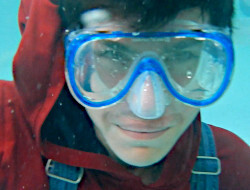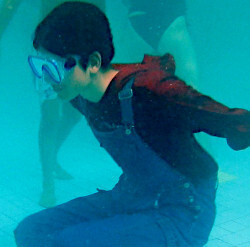Capsize Training
Once you can prove you are competent at swimming, you'll learn how to capsize in the pool. The capsize drill really is fun! Everyone has to practice the capsize which is carried out in the controlled environs of a local swimming pool, under the instruction of a qualified coach. It is important that you do this calmly without panicking.
Blades
Some capsize drills are run complete with blades to make the capsize process a bit more realistic, but many are run without blades.
Rock and Roll
The slim boat tips over with easy. A slight rocking movement and you roll into the water. As you fall out of the seat, make sure you feet slip out of the footrest.
Hold On
The boat is your floatation device.
All rowers are taught to never leave the boat
unless specifically instructed to so by a safety launch or other person providing assistance.
For a sleek scull, reaching over the top of the overturned boat is pretty straightforward.
If it is a bigger boat, athletes can often kick their legs to push themselves up onto the hull for more safety.
Helpers and Pool Depth
Helpers keep a safe distance but can quickly assist. The depth of the pool should be shallow enough so that the helpers can stand firmly on the pool bottom in case they need to turn the boat, but deep enough so that the rower’s head does not get too close to the bottom of the pool.
The helpers should be fully clothed in hoodies and jeans to reduce the risk of injury from the rotating boat. A snorkelling mask lets the helper see clearly under the water and monitor the rower’s progress. Without a snorkel the helper feels the sensation of holding their breath along with the rower. As time ticks along the helper has some sense how short the air gets.

The helper keeps an eye on capsizing rowers.

Open Water
Later you move onto open water to purposely capsize a single skull, surface and paddle the boat back to the shore or riverside. Also jump out of the boat and use it as a buoyancy aid. Get on top of the upturned hull.
Wear the right clothes
In cold weather wear enough of the right clothes:
several layers, but not heavy layers which can get wet and make matters worse.
You must be able to swim in these clothes.
Practice this often.
A warm hat and scarf are surprisingly effective at keeping you warm and do not interfere with your rowing.
A “technical” base layer will keep you warm without overheating.
If you fall in, stay with the boat
You should have practised a capsize drill and know not to panic. Sudden immersion in cold water can lead to the initial deep gasping, uncontrollable rapid breathing, with possible dizziness and pins and needles, and panic reaction which are the symptoms of cold shock.
If you see any of these happening, the person needs immediate help.
Talk to them and try to calm them down while getting them out of the water by the fastest possible means.
Reader Comment: Capsize Test
by Andreas, studying sports science in London, EnglandYou may love being on the water and rowing but who loves to capsize? Maybe if you’re 10 years old or young at heart.
About 30 keen students turned up at the swimming pool for the capsize drill. Most appeared to be terrified, either of having to swim 200 meters fully clothed with 30 other people splashing around, or having to capsize, right the boat and climb back in front of not only fellow capsizers, but also coaches plus many junior students.
The swim round the pool was over in minutes and by then we were soaking wet and not so bothered about getting more doused again. The junior helpers and coach managed to be totally fabulous and making us feel in safe hands.
Everyone turned out to be rather British, forming an orderly queue, and then clapping cheerily as each person went through the drill and survived. I can honestly say it was great fun. But we only have to do it once, right? Bring it on every month!